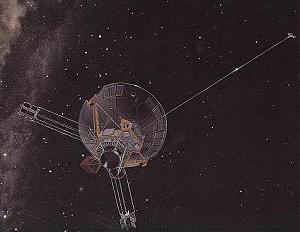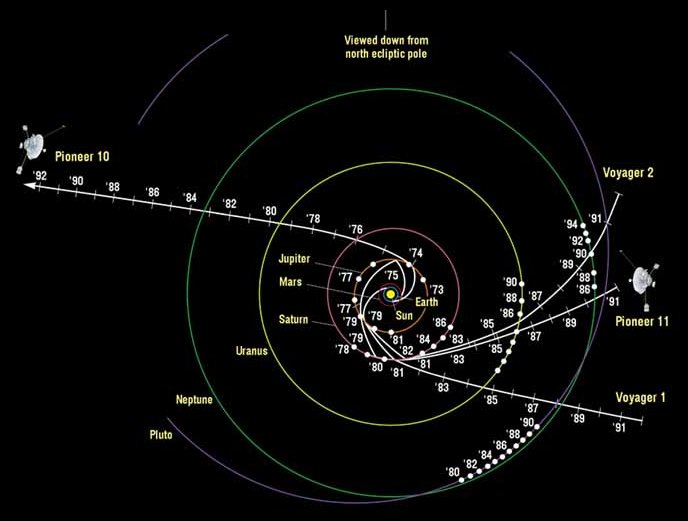Pioneer anomaly

Both Pioneer 10 and 11 are slightly off course.

The trajectories of Pioneer's 10 and 11 and Voyager's 1 and 2 up to 1992.
The anomalous deceleration of the twin Pioneers was inferred from a small, constant, anomalous Doppler shift in the frequency of radio signals received from the spacecraft. Various explanations were put forward to account for the so-called Pioneer Anomaly. Although it was always suspected that there might be a systematic origin to the effect, such as thrust from a gas leak, none had been found. Some scientists therefore began to consider more exotic explanations, including the possibility that our understanding of gravity might need to be revised.
Origins of the mystery
Pioneer 10 was launched in 1972 and became the first spacecraft to fly past Jupiter. Its identical sister craft, Pioneer 11, was launched the following year and subsequently flew past both Jupiter and Saturn. Both are now heading out of the Solar System but in completely different directions. For details of the spacecraft and where they are heading, see the pages on the respective probes.
From about 1980 on, evidence began to accumulate for what became known as the Pioneer anomaly. This evidence was first brought to light and, was subsequently analyzed, by John Anderson (Pioneer 10 Principal Investigator for Celestial Mechanics) and his colleagues at the Jet Propulsion Laboratory in Pasadena. Their first published results appeared in 1998; 1 these prompted a number of articles in publications such as Scientific American (December 1998 issue) and Newsweek magazine (4 October 1999 issue) which brought the phenomenon to widespread public attention. Anderson and coworkers wrote a second paper, which appeared in 2002, discussing the anomaly further.2
The JPL team pointed to data from the Ulysses and Galileo spacecraft which suggested that a similar effect might be at work on these probes. However, it was hard to draw firm conclusions in the case of Ulysses and Galileo partly because they hadn't traveled as far from the Sun as had Pioneers 10 and 11. The Voyager 1 and Voyager 2 spacecraft, which had now gone even further from the Sun than the Pioneers, weren't a helpful as might have been expected in contributing to the investigation of the Pioneer anomaly because of the way in which they are stabilized. Unlike the Pioneers, which are spin-stabilized, the Voyagers have what is known as three-axis stabilization. This results in an greater uncertainty in the spacecrafts' theoretical positions. The uncertainty was great enough to mask any deceleration similar in magnitude to that seen in the Pioneer probes.
Possible explanations
A variety of possible causes of the Pioneer anomaly were considered, ranging from the mundane to the exotic. These included:
• observational errors, including measurement and computational errors, in deriving the acceleration
• approximation/statistical errors
• possible corruption to the radio Doppler data
• gas leaks, including helium produced by radioactive decay escaping from the spacecrafts' radioisotope thermoelectric generators (RTGs)
• thermal radiation from the RTGs
• interactions between the solar wind and the spacecraft
• radiation pressure resulting from the tiny transfer of momentum when solar photons impact the spacecraft
• electromagnetic forces due to an electric charge on the spacecraft
• wobbles and other changes in Earth's rotation
• perturbations from the gravitational attraction of planets and smaller bodies in the solar system, including the Kuiper Belt
• drag from the interplanetary medium, including dust, solar wind and cosmic rays
• the influence of dark matter
• clock acceleration between coordinate or Ephemeris time and International Atomic Time
• new or revised theories of gravity
Until 2012, it wasn't known which, if any, of these explanations was correct. No spacecraft behavior or previously unknown property of the outer solar system had been able to explain the anomalous decelerations. Hence, although scientists expected that in the end a mundane explanation was most likely, they were forced to consider theories that involved a change in our understanding of the laws of physics.
Further research
One problem hampering researchers early on was that the only data available to them about the movements of the Pioneers was from 1987 onward. The reason for this is that earlier data received from the probes was stored on magnetic tapes in a format that could only be handled by antiquated computers. NASA was unwilling at the time to allocate resources to analyze this data. Consequently, Anderson and his colleagues approached the Planetary Society, requesting funds in order that the data could be recovered and made available to researchers wishing to look further into the Anomaly. The Planetary Society appealed to its members and received the support needed for the recovery to go ahead.
At the same time, other lines of research were proposed, such as close observation of other spacecraft heading for the outer solar system, including New Horizons, which is bound for Pluto and the Kuiper Belt. Unfortunately, New Horizons suffered from a similar drawback in this respect to the Cassini spacecraft – namely, that its RTGs are mounted close to the spacecraft's body, so infrared radiation from them, bouncing off the spacecraft, would produce a systematic thrust of a not-easily predicted magnitude, several times as large as the Pioneer effect.
Another suggestion, made by Gary Page of George Mason University and his colleagues, was to use remote asteroids to test if an unknown gravitational factor is the cause of the anomaly. They identified 15 asteroids that they considered might be subject to the mysterious force; all of the asteroids' orbits stretched far into the outer solar system where the anomaly had made itself felt.
Mystery solved
In 2004, with the money provided by the Planetary Society and some funds which eventually came in from NASA, a group of researchers, led by Slava Turyshev, at JPL, started to gather, extract, and analyze all the data held in earlier records of the Pioneer probes. At the back of their minds was the possibility of proposing a new deep space mission to investigate the Anomaly if they couldn't find an answer to the mystery.
Turyshev and his colleagues copied digitized files from the original navigation computer that had helped steer the Pioneers, found more than a dozen boxes of magnetic tape under a staircase at JPL, and received archived files from other NASA centers. They even managed to save an old tape machine from being scrapped in order to play the tapes.
From these various sources, the researchers were able to extract enough Doppler and telemetry data, stretching back to the launch of the spacecraft, to solve the puzzle once and for all. It turned out that the heat given off by the electrical subsystems of the probes and the decay of their plutonium thermoelectric power sources was just right to explain the puzzling deceleration. The spacecrafts' own heat emanations were what was pushing them back, very, very slightly. As Turyshev explained: "The effect is something like when you're driving a car and the photons from your headlights are pushing you backward." The results were published in the 12 June 2012 issue of Physical Review Letters.3
References
1. Anderson, J. D., P. A. Laing, E. L. Lau, A. S. Liu, M. M. Nieto, and
S. G. Turyshev."Indication, from Pioneer 10/11, Galileo, and Ulysses
Data, of an apparent anomalous, weak, long-range acceleration." Phys.
Rev. Lett. 81, 2858–2861, (2012).
2. Anderson, J. D., P. A. Laing, E. L. Lau, A. S. Liu, M. M. Nieto, and
S. G. Turyshev. "Study of the anomalous acceleration of Pioneer 10 and
11." Physical Review D 65 082004, (2002).
3. Turyshev, S. G., Toth, V. T., Ellis, J., and Markwardt, C. B. "Support
for temporally varying behavior of the Pioneer anomaly from the extended
Pioneer 10 and 11 Doppler data sets". Physical Review Letters (APS) 107 (8), (2012).


